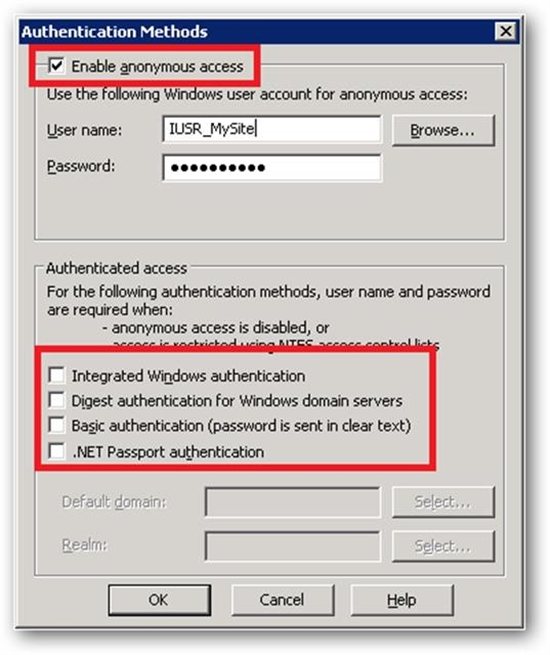Authentication Precedence and Behavior in IIS
Introduction
This blog seeks to explain which authentication mode will take precedence when multiple authentication mechanisms like Anonymous, Basic, Windows are enabled. Please note that the following instructions are applicable only to ASP.Net applications and Internet Explorer.
Authentication Precedence
The best way to find out which authentication mode will take precedence is to revisit the IIS 6 Directory security Tab. The order in which authentication modes are presented from top to bottom indicates the authentication precedence. For example, Anonymous Authentication will take precedence over Windows, Digest and Basic authentication. However, if the client Certificate Authentication is configured, then it will take precedence above all other authentication mechanisms since the SSL handshake takes place even before the HTTP request comes into picture.
To Summarize everything, this is how the authentication precedence looks like.
- Client Certificate Authentication
- Anonymous authentication
- Windows authentication
- Basic authentication
Authentication Behavior
Scenario 1 - Only Anonymous authentication enabled
Under any given circumstances, when a client makes the first request to the server, it will be anonymous. On the server side, if the application is also configured to run under anonymous authentication, then the server will process the request and send the desired response back to the client without requesting any further validation from the client.
Scenario 2 - Multiple authentication modes enabled
Let us assume that both Basic and Windows authentication have been enabled on the server at the application level. When the first anonymous request from the client reaches the server, the server checks the application's configuration and understands that it is configured to run under Basic/Windows authentication. Since these authentication mechanisms need further validation to deliver the required page, the server sends the authentication details to the client and requests for further validation. The client picks up the most secure authentication mechanism(windows) from the list provided by the server and takes necessary steps to provide the required information to the server.
It is incorrect to assume that if two authentication modes are configured and if one fails, the request will fall back to other authentication mode. If you consider my previous example, I stated that if Windows Authentication and Basic Authentication are enabled, Windows authentication will take precedence. Now, if Windows authentication fails, it will never fall back to Basic and take it forward from there.
A fall back would mostly occur only in following scenarios.
- Scenario 1: Under Windows Authentication, if Kerberos fails, it will fall back to NTLM
- Scenario 2: If client Certificate Authentication and Anonymous authentication are enabled on the server at the application and if client Certificate Authentication fails, then the request will fall back to Anonymous authentication. If you're setting up client certificate authentication in your environment, please make sure you have anonymous authentication disabled so that you don't end up receiving false positive answers.
Hope this helps :)
Comments
- Anonymous
December 12, 2016
Hi thanks for the blog, its too late to comment, actually I have some doubts,1. If all the authentications have a precedence/preference property, then what is the benefit of applying two authentications from IIS?2. If I apply windows authentication over whole application from IIS and from the web.config provide anonymous access to some htmls/ views, do you think it will work?3. How is it decided to look for web.config for picking up authentication mechanism, becuase we already provide one from IIS?Regards,Yashashwi Srivastava- Anonymous
February 09, 2017
Hi Yashaswi, Here are your answers.1. 1. If all the authentications have a precedence/preference property, then what is the benefit of applying two authentications from IIS?Ans: Irrespective of how many authentication mechanisms you enable on IIS, only one will be picked for a particular application/page. In other words, there is no benefit as such of having multiple authentication mechanisms enabled. So in ideal situation, you should have just one authentication mechanism enabled for an application. But many users enable multiple authentication mechanisms for one application and this blog explains the concept as to which authentication mechanism will be picked in such situations. 2. If I apply windows authentication over whole application from IIS and from the web.config provide anonymous access to some htmls/ views, do you think it will work?Ans: By Default, any changes you make on IIS gets saved in the application's web.config file and sometimes inside the ApplicationHost.config file (based on the scope of the setting). So, in the example that you have provided, it does not matter where you enable it from, you will still have both anonymous and windows authentication enabled. And in such a scenario, anonymous authentication will always take precedence. Having said that, if you do not want to implement windows authentication on specific pages, disable windows and enable only anonymous authentication at page level.3. How is it decided to look for web.config for picking up authentication mechanism, becuase we already provide one from IIS?Ans: As mentioned in my previous answer, any change done through IIS will get reflected either in the application's web.config file or in the ApplicationHost,config file. Try this, select "authentication" tab under your website on IIS and observe the bottom of your screen, you will be able to see the file which is being modified. (Default: web.config file).Hope this answers all your queries :) :) Please feel free to reach out to me in case you have any follow up questions !!
- Anonymous
- Anonymous
February 01, 2017
Outstanding post however I was wondering if you could write a litte more on this subject? I'd be very thankful if you could elaborate a little bit further. Bless you!- Anonymous
February 10, 2017
Thank you so much ! Please let me know what topic in particular you would like me to discuss :)
- Anonymous
- Anonymous
June 16, 2018
Enjoyed every bit of your blog article.Really looking forward to read more. Want more.
